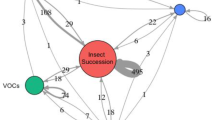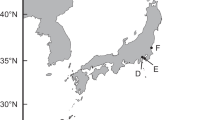Abstract
In this article, we show how a disease could bias stable isotope analyzes of trophic networks and propose a strategy in the choice of tissues to be analyzed. In the past few years, a new pathology (brown muscle disease or BMD) affecting the posterior adductor muscle of Ruditapes philippinarum has emerged in Arcachon Bay. BMD induces a necrosis of muscle tissues which become infused by conchiolin and hence calcified. As muscle of mollusks are often used for trophic food webs studies through stable isotopic analyzes, this work investigated the effect of BMD on carbon and nitrogen isotopic ratios of anterior and posterior adductor muscles of clams collected in February and August 2007. Infected clams displayed a lower condition index and a posterior adductor muscle δ13C enrichment of 1.2‰ in February and 0.7‰ in August. δ15N of posterior muscles was however not affected by the disease. Anterior muscle of diseased clams remained healthy and displayed the same isotopic signature as both posterior and anterior muscular tissues of healthy clam. Acidification significantly depleted δ13C in posterior muscles of infected clams, suggesting calcification, contrary to anterior muscles of infected clam and to both muscles of healthy clams, where no effect was observed. An X-ray diffractometry analysis confirmed the presence of CaCO3 (aragonite). Trophic food web studies relying on stable isotope ratios should utilize only healthy animals or anterior adductor muscles when expertise in mollusk pathology is lacking.





Similar content being viewed by others
References
Dang C, de Montaudouin X, Gonzalez P, Mesmer-Dudons N, Caill-Milly N (2008a) Brown muscle disease (BMD), an emergent pathology affecting Manila clam Ruditapes philippinarum in Arcachon Bay (SW France). Dis Aquat Organ 80:219–228. doi:https://doi.org/10.3354/dao01941
Dang C, Gonzalez P, Mesmer-Dudons N, Caill-Milly N, Bonami JR, De Montaudouin X (2008b) Virus-like particles associated with brown muscle disease in Manila clam (Ruditapes philippinarum) in Arcachon Bay (France). J Fish Dis (in press)
DeNiro MJ, Epstein S (1978) Influence of diet on the distribution of carbon isotopes in animals. Geochim Cosmochim Acta 42:495–506. doi:https://doi.org/10.1016/0016-7037(78)90199-0
DeNiro MJ, Epstein S (1981) Influence of diet on the distribution of nitrogen isotopes in animals. Geochim Cosmochim Acta 45:341–351. doi:https://doi.org/10.1016/0016-7037(81)90244-1
Deudero S, Pinnegar JK, Polunin NVC (2002) Insights into fish host-parasite trophic relationships revealed by stable isotope analysis. Dis Aquat Organ 52:77–86. doi:https://doi.org/10.3354/dao052077
Flassch JP, Leborgne Y (1992) Introduction in Europe, from 1972 to 1980, of the Japanese Manila clam (Tapes philippinarum) and the effects on aquaculture production and natural settlement. ICES Mar Sci Symp 194:92–96
Fry B, Sherr EB (1984) d13C measurements as indicators of carbon flow in marine and freshwater ecosystems. Contrib Mar Sci 27:13–47
Goulletquer P, Héral M, Béchemin C, Richard P (1989) Anomalies de calcification chez la palourde japonaise Ruditapes philippinarum: caractérisation et comparaison des compositions en acides aminés de différentes parties de la coquille analysées par HPLC. Aquaculture 81:169–183. doi:https://doi.org/10.1016/0044-8486(89)90243-3
Jing G, Yan Z, Li Y, Xie L, Zhang R (2007) Immunolocalization of an acid phosphatase from pearl oyster (Pinctada fucata) and its in vitro effects on calcium carbonate crystal formation. Mar Biotechnol 9:650–659. doi:https://doi.org/10.1007/s10126-007-9018-0
Kanaya G, Nobata E, Toya T, Kikuchi E (2005) Effects of different feeding habits of three bivalve species on sediment characteristics and benthic diatom abundance. Mar Ecol Prog Ser 299:67–78. doi:https://doi.org/10.3354/meps299067
Kasai A, Horie H, Sakamoto W (2004) Selection food sources by Ruditapes philippinarum and Mactra veneriformis (Bivalva: Mollusca) determined from stable isotope analysis. Fish Sci 70:11–20. doi:https://doi.org/10.1111/j.1444-2906.2003.00764.x
Laruelle F, Guillou J, Paulet YM (1994) Reproductive pattern of the clams, Ruditapes decussatus and R. philippinarum on intertidal flats in Brittany. J Mar Biol Assoc UK 74:351–366
Lassalle G, de Montaudouin X, Soudant P, Paillard C (2007) Parasite co-infection of two sympatric bivalves, the Manila clam (Ruditapes philippinarum) and the cockle (Cerastoderma edule) along a latitudinal gradient. Aquat Living Resour 20:33–42. doi:https://doi.org/10.1051/alr:2007013
Lorrain A, Paulet Y-M, Chauvaud L, Savoye N, Donval A, Saout C (2002) Differential δ13C and δ15N signatures among scallop tissues: implications for ecology and physiology. J Exp Mar Biol Ecol 275:47–61. doi:https://doi.org/10.1016/S0022-0981(02)00220-4
Machás R, Santos R, Peterson B (2003) Tracing the flow of organic matter from primary producers to filter feeders in Ria Formosa lagoon, southern Portugal. Estuaries 26:846–856. doi:https://doi.org/10.1007/BF02803343
Malet N, Sauriau P-G, Faury N, Soletchnik P, Guillou G (2007) Effect of seasonal variation in trophic conditions and the gametogenetic cycle on δ13C and δ15N levels of diploid and triploid Pacific oysters Crassostrea gigas. Mar Ecol Prog Ser 346:203–217. doi:https://doi.org/10.3354/meps06953
McCutchan JHJ, Lewis WMJ, Kendall C, McGrath CC (2003) Variation in trophic shift for stable isotope ratios of carbon, nitrogen, and sulfur. Oikos 102:378–390. doi:https://doi.org/10.1034/j.1600-0706.2003.12098.x
Page HM, Lastra M (2003) Diet of intertidal bivalves in the Ría de Arosa (NW Spain): evidence from stable C and N isotope analysis. Mar Biol (Berl) 143:519–532. doi:https://doi.org/10.1007/s00227-003-1102-z
Paillard C (2004) A short review of brown ring disease, a vibriosis affecting clams, Ruditapes philippinarum and Ruditapes decussatus. Aquat Living Resour 17:467–475. doi:https://doi.org/10.1051/alr:2004053
Peterson BJ, Fry B (1987) Stable isotopes in ecosystem studies. Annu Rev Ecol Syst 18:293–320. doi:https://doi.org/10.1146/annurev.es.18.110187.001453
Sokal RR, Rohlf FJ (1981) Biometry. The principles and practice of statistics in biological research. Freeman W.H. and Co., NJ, pp 1–859
Acknowledgments
We are particularly grateful to E. Lebraud from Institut de Chimie et de la Matière Condensée de Bordeaux to permit us to realize diffractometry analyzes; to P. Lebleu, F. Prince for their assistance in the field; I. Billy, K. Charlier for technical assistance with elemental analyzer. The study was partly financed by ANR (Multistress project). C. Dang was supported by a grant from Fonds Commun de Coopération Aquitaine-Euskadi and Conseil Général de la Gironde. Thanks to R. B. Carnegie for discussion and English editing. The experiments comply with the current laws of the country in which the experiments were performed.
Author information
Authors and Affiliations
Corresponding author
Additional information
Communicated by U. Sommer.
Rights and permissions
About this article
Cite this article
Dang, C., de Montaudouin, X., Savoye, N. et al. Stable isotopes changes in the adductor muscle of diseased bivalve Ruditapes philippinarum . Mar Biol 156, 611–618 (2009). https://doi.org/10.1007/s00227-008-1112-y
Received:
Accepted:
Published:
Issue Date:
DOI: https://doi.org/10.1007/s00227-008-1112-y




